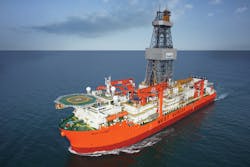BP has added two drilling rigs to the deepwater Gulf of Mexico, making it a company record nine rigs as it continues to develop its portfolio of assets in the United States offshore basin.
One of the rigs is a new ultra-deepwater drillship known as the West Auriga that is under long-term contract to BP from Seadrill Ltd, an international offshore drilling contractor. The vessel, capable of operating in up to 12,000 feet of water, has begun development drilling work at BP’s Thunder Horse field.
RELATED: BP Starts up New Crude Unit at Whiting, Ind.
The other is a reconstructed drilling rig on BP’s Mad Dog oil and gas production platform. It replaces the original rig on the platform that was badly damaged and left inoperable by Hurricane Ike in 2008. With the new, state-of-the art rig, the platform recently resumed development drilling at the massive Mad Dog field complex.
“The addition of these two rigs reflects the vital importance of the deepwater Gulf of Mexico to the future of BP,” said Richard Morrison, regional president of BP’s Gulf of Mexico business. “It also clearly demonstrates BP’s commitment to the American economy and to U.S. energy security.”
BP currently anticipates investing on average at least $4 billion in the Gulf of Mexico each year for the next decade. The company plans to concentrate future activity and investment in the Gulf on growth opportunities around its four major operated production hubs—Thunder Horse, Na Kika, Atlantis, and Mad Dog—and three non-operated production hubs—Mars, Ursa, and Great White—in the deepwater, as well as on significant exploration and appraisal opportunities in the Paleogene and elsewhere.



